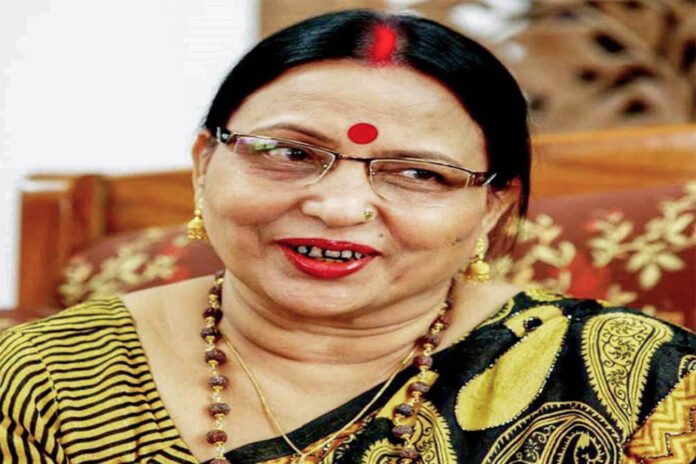She was the second singer after Girija Devi, Who was loved and respected by the people of Hindi state. There was a difference in the singing of both but the personality was the same. Both are rooted in their culture. Both dedicated to singing. Sharda Sinha, born in 1952 in Hulas of Supaul district in Bihar, had a long tradition of singing Bhojpuri folk songs even before her, but she made it popular at the international level.
Vimal Kumar
Any art can neither be popular nor immortal without the public. It is the common people who spread art far and wide. Tulsi and Kabir are examples of this. The emphasis of Bhikhari Thakur, Rahul Sankrityayan, Banarasi Das Chaturvedi, Ramnaresh Tripathi, Devendra Satyarthi was also on saving and preserving these folk songs and folk culture. Sharda Sinha, through her singing, tried to save this world in this era of globalization and market. Perhaps this may have been the reason that when he died late on Tuesday night, not only Bihar but the entire Hindi belt became mournful. President Draupadi Murmu and Prime Minister Narendra Modi along with many people from politics, art and film world expressed their condolences.
Earlier, the Prime Minister had also spoken to Sharda Sinha’s son on telephone. For the last one week, when she was admitted in AIIMS, it seemed as if the entire country was praying to God to save her. Her son had also made a heart-wrenching appeal on social media that people should pray for his mother, but who can postpone the fate and what happened was as per destiny’s approval. The voice of a folk singer became silent forever.
She was the second singer after Girija Devi, who was loved and respected by the people of Hindi heartland. There was a difference in the singing of both but the personality was the same. Both are rooted in their culture. Both dedicated to singing. Sharda Sinha, born in 1952 in Hulas of Supaul district in Bihar, had a long tradition of singing Bhojpuri folk songs even before her, but she made it popular at the international level. His songs were popular as far as Mauritius and Fiji. Overseas Biharis also heard him in Britain and America.
In the 90s, his songs created a stir in every street. That was the era of T series cassettes. Now is the era of reel. Sharda ji was on Facebook. He had 70 lakh followers. Sharda ji was an accomplished singer. Had a PhD in Music. Educated from Magadh Mahila College, Patna. Sharda ji also received the Sangeet Natak Akademi Award.
His songs became popular in every household. His songs were like background music of Mahaparva Chhath. The sanctity of Chhath was further enhanced by his songs. But not just Chhath, without his songs no auspicious work was accomplished in Bhojpuri, Maithili and Magahi regions. The songs sung by him of love and separation are an example of the purity of language and music. He sang only selected songs for Bollywood but those songs are immortal. He also received the Padma Shri in 1991 and the Padma Bhushan in 2018. If we talk about popularity through folk music, then before her Teejan Bai had also become popular in the same way in her state of Chhattisgarh. One song of Sharda ji became very popular ‘Bataava Chand Kekra Se Kahan Mile Jaala’. Finally Sharda ji also went to meet her moon. Her husband had passed away a few months ago.
Sharda ji, who carried forward the tradition of Bhikhari Thakur, Mahendra Misir and Vindhyavasini Devi in Bihar, was a symbol of women empowerment. This was a recent example of how a folk singer becomes immortal among his people. Her songs proved once again that Indian women have preserved the folk songs. In Bhojpur region, deep pain was expressed in the songs of Sharda ji, the voice of woman’s pain, separation, love, affection, marriage songs, Chhath songs. Women outside Bhojpur region also found their expression in her voice.
Rejecting the vulgarity of Bhojpuri films, he sang pure and virtuous songs and said that this is the truth, this is the culture. She left at a time when many singers have vulgarized Bhojpuri culture. Sharda Sinha preserved the soul of Bhojpuri in her songs. He did not compromise with the market. Preserved the quality and purity of his songs. Taking forward the tradition of Bhojpuri songs filmed on Kumkum in the sixties, Sharda ji sang the songs. Because of this a new era of Bhojpuri culture and songs had emerged. She progressed purely on the strength of her talent. Sharda ji proved through her songs that it is the power of the people that makes art popular. He told that popularity also has quality. He preserved both the popularity and quality of Bhojpuri songs. He also immortalized Mahendra Misir through his songs.
Sharda ji remained a common woman with the smell of her culture in her dress, lifestyle and speech. She told how a woman can climb the stairs of success with her culture. In his songs, he has also attacked injustice, discrimination and neglect of women and feudal patriarchy. His songs also appeal to save the joint family. The pain and irony of life has also been expressed. There is a deep pain in his voice. The pain of a woman who tears your heart apart. There is a whole family in his singing. Husband, brother-in-law, sister-in-law, mother-in-law, father-in-law, everyone is there. Only then will Sharda Sinha always be remembered the same way we remember Bhikhari Thakur today.

